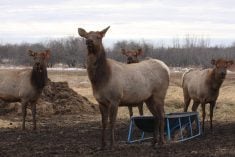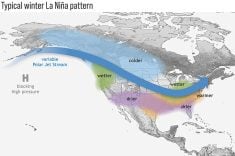What is the most likely crop that prairie farmers will do anything to seed, come muddy hell or high water?
If last year is anything to judge by, it is canola.
Five million acres were left as summerfallow last year because it was too wet to seed. It is not clear how this seeding season will play out.
There are differences. Last year we went into spring dry and then it wouldn’t stop raining. This year we started off saturated, but rain has been less of a problem unless you farm in southeastern Saskatchewan or southwestern Manitoba.
Read Also

Canadian Food Inspection Agency extends chronic wasting disease control program consultation deadline
Date extended for consultation period of changes to CWD program
Still, there are likely to be unseeded acres.
Farmers who had to sacrifice a crop last year were likely to ditch oats, barley and wheat, but not canola.
Farmers told the March 2010 seeding report that they intended to seed 8.34 million acres to barley, but planted only 6.91 million acres.
They intended to seed 3.99 million acres of oats but only planted 2.9 million acres, and intended to seed 18.1 million acres of spring wheat but planted 16.5 million acres.
However with canola, they seeded almost everything intended. They planned on 16.9 million acres and got 16.8 million in the ground.
They harvested much less of each crop than they seeded because of the heavy rain and flooding that hit during the growing season.
This year, farmers told Statistics Canada they intend to seed a record 19.2 million acres of canola. From last year’s experience, it would seem a safe bet that farmers will try to seed as much of that as they can.
However, there are also market differences this year. Canola’s price attractiveness is not as dominant.
Oat prices were dismal at seeding time last year. This year they are up 112 percent, which should increase the incentive to get oats in the ground.
The spring wheat Pool Return Outlook is up 55 percent from last year and canola futures are up 45 percent.
Overall, there is a huge incentive to seed as much as possible because of higher prices. The market will be interested in the actual seeded acreage report and will concentrate on the canola number. There are lots of wheat and barley producers in the world and losing one or two million Canadian wheat or barley acres is significant but not a crisis.
However, Canada dominates the canola export market.
Agriculture Canada forecasts that 18.89 million canola acres will be harvested with an average yield of 31 bushels per acre, producing a record crop of 13.3 million tonnes, up from 11.89 million last year.
However, a smaller carry-in will result in total supply similar to last year, and Agriculture Canada forecasts similar demand, which will lead to another year of tight stocks at the end of the crop year and good prices.
Production problems in Europe and China that are tightening canola’s global fundamentals mean there is good reason to believe that forecast.














